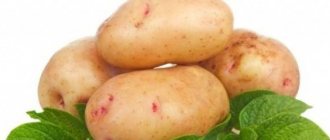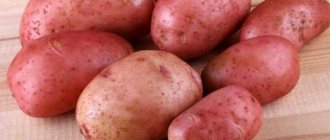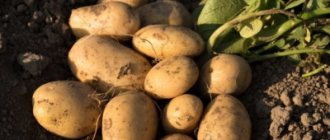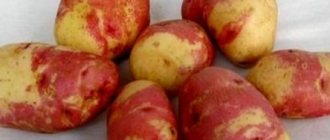Description of the variety
Belmondo is the result of the work of German breeders, employees of the Solagro Seed Alliance.
When grown in European countries, this variety of vegetable crop showed excellent results. Under any climatic conditions, the variety gives a good harvest. The growth of tubers on the bushes is uniform and rapid. No more than 80 days pass from planting to harvesting potatoes.
Pictured are Belmondo potatoes.
Reference. Belmondo is characterized by pleasant taste. Potatoes are slightly boiled, their flesh does not darken during heat treatment. Suitable for frying, boiling, salads.
Difference from other varieties
Belmondo differs from other popular varieties in its hardiness. It is not fussy to care for and is consistently productive under unfavorable climatic conditions.
Potatoes are distinguished by their presentation, regular oval shape. Their weight ranges from 100 to 150 g.
Potatoes can easily be transported and have a high shelf life of 97%.
The table compares the characteristics of Belmondo with other potato varieties.
Chemical composition, trace elements and vitamins
Belmondo variety tubers are rich in substances beneficial to the human body:
- proteins;
- minerals (potassium, iron, iodine, molybdenum, phosphorus);
- antioxidants (carotene, lycopenes);
- omega-3 acids;
- B vitamins, as well as folic and ascorbic acids.
Potatoes of this variety contain a lot of sucrose, amino acids and fatty acids (oleic, linolenic). The purine concentration ranges from 5 to 6 mg per 100 g of potatoes.
Characteristics of tubers and yield
Belmondo is a high-yielding variety. About 80 tons of crop are obtained from 1 hectare of planting. One bush produces up to 16 potatoes.
Tubers of this variety have the following characteristics:
- oval shape;
- medium size (potato reaches 9 centimeters in diameter);
- average weight 120 g;
- yellowish peel with a smooth dense surface;
- the presence of small superficial ocelli;
- yellow flesh;
- starchy index – 16%.
Belmondo bushes are characterized by:
- tall spreading stems;
- wrinkled dark green leaves with a wavy edge (the leaves correspond to the shape typical for this vegetable crop);
- flowers with a dark red or pale purple corolla.
Growing regions and planting dates
The variety was successfully tested in fields in the Tula and Vladimir regions. The manufacturer recommends Belmondo for cultivation in all regions of the country.
Article on the topic: Potato variety “Cossack” - description and photo
Potatoes of this variety should be planted in mid-April or early May. Tubers are planted in soil heated to +8°C to a depth of 10 centimeters. Planting dates are determined by the climatic conditions of the area:
- for northern regions - the second half or end of May;
- for temperate latitudes - early May;
- for the southern regions - mid-April.
Potatoes are planted in deeply loosened soil, choosing a dry, cloudy day for planting.
The history of the origin of the Belmondo potato variety
Belmondo potatoes were developed by breeders from Germany. Originator: German Seed Alliance.
It is not officially registered in the State Register of Russia , however, trial plantings are being carried out, which are carried out jointly by German and Russian scientists.
Excellent results are achieved almost throughout Russia.
The table below presents data on the yield of other potato varieties:
| Name | Variety | Productivity |
| Nikulinsky | Late ripening | From 170 to 300 centners per hectare. |
| Cardinal | Late ripening | From 200 to 350 centners of potatoes are harvested from 1 hectare. |
| Rocco | Late ripening | From 350 to 400 centners per hectare. |
| Kiwi | Late ripening | From 1 kg of planting tubers it reaches 20 kg. |
| Picasso | Late ripening | From 1 hectare about 20 tons. |
| Borovichok | Early ripening | 200-250 centners per 1 hectare of land. |
| Elmundo | Early ripening | 250-350 centners per hectare. |
| Felox | Early ripening | 250 centners per hectare. |
| Bellarosa | Early ripening | The harvest from one bush is 8-10 tubers. |
| Natasha | Early ripening | From 130 to 190 centners per hectare. |
| Forty days | Extra early | Up to 300 centners of potatoes are harvested from one hectare of soil. |
| Karatop | Extra early | From 18.5 to 27 tons per hectare (Middle Volga region), from 20 to 43.5 tons per hectare (Northwestern region). The maximum yield is 50 tons per hectare. |
| Riviera | Extra early | After the first digging on the 45th day after the emergence of potato shoots, it ranges from 134 to 225 centners per hectare. The maximum yield by the end of the growing season reaches 450 centners per hectare. |
| Zhukovsky early | Extra early | The harvest from one bush is up to 15 tubers. |
| Minerva | Extra early | Fertile soils allow you to harvest the first harvest of up to 230 centners per hectare. By the end of the growing season (45-50 days), the maximum yield is achieved - up to 430 centners per hectare. |
| Crane | Mid-late | 640 centners per hectare. |
| Sorcerer | Mid-late | Productivity varies from 27 to 35 tons per hectare. |
| Mozart | Mid-late | The average yield is approximately 430 c/ha. |
| Grenada | Mid-late | From one hectare you can harvest up to 60 tons of potatoes. |
| Ramona | Mid-late | The yield is consistently average from 10 to 15 tons per hectare. |
| Yanka | Mid-early | The average yield ranges from 195 to 315 centners per hectare. |
| Giant | Mid-early | The average harvest ranges from 290 to 424 centners per hectare. |
| Tuscany | Mid-early | Productivity varies from 210 to 400 centners per hectare. |
| Purple Haze | Mid-early | Productivity varies from 182 to 309 centners per hectare. |
| Santana | Mid-early | The average yield varies from 164 to 384 centners per hectare. |
Advantages and disadvantages of the variety
Belmondo potatoes have a number of advantages:
- high yield;
- the presence of immunity in the tubers, which determines their resistance to various diseases;
- ability to adapt to different climatic conditions;
- uniform size, shape and weight of potatoes;
- excellent taste characteristics, abundance of nutrients in potatoes;
- lack of tendency of tubers to germinate again.
Disadvantages of the variety:
- susceptibility to virus Y;
- average resistance to leaf curling;
- sensitivity to heavy rainfall and drought;
- demands on the soil.
Application
"Belmondo" is a table variety. Intended for consumption.
Potatoes contain a lot of useful substances (vitamin C, B, potassium, phosphorus, protein, etc.), which are used for cosmetic and medical purposes - against edema, tumors, and some prevention of high blood pressure.
Yellow potatoes contain a large amount of carotene, an antioxidant substance that performs a cleansing function in the body.
It is not recommended to eat green or sprouted, soft root vegetables; they contain many times more of the toxic substance - salonin - than healthy, strong tubers; discard such tubers or cut off the peel as thick as possible.
Features of planting and growing
Potatoes of this variety are grown following the general rules of vegetable agricultural technology.
Preparing for landing
The planting area should be well lit. The variety loves loose, fertile soil. Its preparation is carried out in the autumn.
It consists of the following works:
- digging up soil, removing root debris;
- introduction of potassium-phosphorus compounds;
- sowing an area for planting potatoes with winter green manure.
Spring soil preparation for planting involves the use of nitrogenous mixtures. The variety feels good in soil with a pH of 5.5-6.0.
It is necessary to prepare planting material in advance. They begin to germinate a month before planting in open ground. The tubers are selected and dusted with ash powder. Then they are laid out in several layers in boxes and left in a warm room.
Reference. The growth of vegetable crops is stimulated by spraying the planting material with heteroauxin or gibberellin on the day of planting.
Planting scheme and technology
Tubers are planted according to the scheme: 70 centimeters between rows, 35 centimeters between holes.
It is recommended to add a handful of ash and a little dry humus to each hole when planting the Belmondo variety.
Tubers are planted at a depth determined by the type of soil:
- for loose lung – from 8 to 10 cm;
- for loamy soil – from 6 to 8 cm;
- for clayey – from 5 to 6 cm.
If frost is predicted, plantings should be covered with film.
Features of cultivation
Experts recommend growing potatoes in the same area once every 4 years.
You can increase productivity by sowing green manure. They will help improve the soil structure. We are talking about lentils, peas, sweet clover, and alfalfa. Legumes tend to saturate the soil with nitrogen.
For the winter, it is recommended to sow the area for potatoes with rye, oats, mustard, and wheat.
Reference. Combining the planting of Belmondo with sowing the rows with mustard, which serves as green fertilizer, helps to obtain maximum yield.
Nuances of care
Plant care is carried out according to standard rules for mid-early varieties.
Belmondo potatoes when grown need:
- proper watering;
- weeding when the sprouts reach a height of 4 cm (later weeding is combined with hilling, the last time it is carried out when the height of the bush is 30 cm);
- loosening after watering or rain in order to improve soil aeration;
- hilling, which is first resorted to when 6 leaves appear on the sprouts, hilled a second time a week later, a third time when the plant reaches 35 cm in height;
- applying fertilizers;
- mulching the soil.
Watering mode
Before shoots appear, the tubers have enough moisture. Excess liquid causes them to rot.
Article on the topic: Potato variety “Banba” - description and photo
The first watering is carried out when the bush reaches a height of 10-12 cm. More moisture is needed when setting inflorescences. One plant will require 5-6 liters of water when watering twice a week.
Regular watering of the bushes is necessary when tubers are forming. The volume of moisture is calculated taking into account weather conditions. In hot weather, bushes should be watered 6-7 times a month. In moderate weather - no more than three times. The volume of water varies from 4 to 10 liters per bush. During cold weather, plants are watered no more than 3 times a month.
Phosphorus-potassium mixtures are added to the soil for fall plowing. In the spring - nitrogen fertilizing.
During the period of buds and flowering use:
- ammonium nitrate;
- nitrogen sulfate;
- "Nitrophoska";
- chlorine-free NPK fertilizers;
- "Ammophos".
To form strong and long-lasting tubers, calcium nitrate is added to the root. You can also use granular, liquid and bulk formulations.
Disease and pest control
Belmondo is resistant to fungi (late blight, mold, rot), spotting and scab.
When plants wilt at the initial stage, it is permissible to use the following drugs:
The Colorado potato beetle can be gotten rid of by spraying the plantings with chemicals such as:
To prevent plant infection, resort to the following measures:
- remove affected bushes from the garden bed;
- adhere to the rules of crop rotation;
- When storing potatoes, the containers are disinfected;
- The seed is planted away from other nightshades.
Difficulties in growing
The main difficulties that gardeners may encounter when growing the Belmondo potato variety are:
- Infection with virus Y, the main carrier of which is considered to be aphids. To prevent infection of the bushes, it is necessary to use mineral oil together with fungicides and insecticides during each treatment.
- A dry or excessively rainy period can lead to a decrease in yield despite the ease of care and good adaptability of the Belmondo potato variety to any climatic conditions.
- Wrong choice of soil can lead to a decrease in yield. More meticulous care is required.
Disease and pest control
As mentioned earlier, the variety has fairly low resistance to viral infections. Since viral diseases of potatoes are practically untreatable, preventive methods of combating such diseases come first.
First of all, you need to follow the recommended crop rotation scheme with the potatoes returning to their original place of cultivation no earlier than in the 6th year.
The best predecessors are legumes. Also an important aspect of the fight against viral diseases is the proper preparation of planting material.
Preventive measures cannot completely eliminate the problem of this disease, but can significantly reduce the number of diseased potato bushes. Therefore, if you find an affected bush, you must immediately dig it up completely and remove it from the site.
Of the wide list of pests, the variety is most damaged by the Colorado potato beetle.
This pest overwinters in the soil and, with the onset of spring, moves to weeds and then to potato bushes. It is important to detect the Colorado potato beetle in a timely manner, since it has a high reproduction rate and can produce large offspring that can completely destroy the above-ground part of the bush in just a few days.
If more than 5 specimens are found on one bush, it is necessary to immediately spray the bush with the insecticides Karbofos, Metafos or Bombardir.
Harvest and storage
Belmondo, like all early and mid-early varieties, cannot be kept in the garden. The harvest is harvested on time.
Potato harvesting begins at different times depending on the region. It usually occurs in mid-August.
Tubers are stored in stable conditions:
- temperature regime – +1…+4°C;
- humidity – 80-85%;
- the room should be dark and dry.
Tubers do not begin to sprout during a single sprout removal.
How to properly care for the variety
The Belmondo variety is unpretentious. However, proper and regular care increases the possibility of getting a good harvest.
Features of watering
Watering is carried out depending on the growth of the plant and the weather. The first irrigation is carried out when the bushes reach a height of 10-15 cm. After this, the crop is watered weekly, each plant will require up to 5 liters of water.
When buds and flowers appear on the bush, the number of waterings is increased to a couple of times a week, the volume of liquid reaches 10 liters.
Important! With constant rain and cold weather, the amount of irrigation is reduced.
Feeding and fertilizing
Fertilizing the soil begins before planting, during its preparation in the fall, then in the spring. The bushes are fertilized during the formation of buds and flowers. For this purpose, ammonium nitrate, Nitrophoska, and chlorine-free products are used.
Advice from experienced gardeners
Experienced gardeners believe that if in wet weather the tops on potato bushes do not dry out but continue to turn green, then they must be mowed 7-10 days before harvest.
Don’t put off harvesting potatoes from the garden. This has a bad effect on its keeping quality.
Another piece of advice from experienced gardeners is not to plant potatoes near tomatoes and apple trees. They have common pests.
Important ! To increase productivity, it is necessary to select potatoes for planting from healthy bushes in which the tubers were large in size. Small seeding material will not give a high quality harvest.
Reviews about the Belmondo variety are mostly positive. These potatoes are grown in different regions and produce good harvests everywhere.
Nadezhda, Vladimir region: “Belmondo potatoes have excellent taste. This is one of the most delicious yellow varieties. When cooking, the tubers do not become soft. They are great for soups and salads, although they are not very suitable for making purees. Delicious fried."
Zoya, Perm: “The Belmondo potato variety adapts to different climates, showing high yields and maintaining excellent taste. It is considered one of the most promising European varieties. Belmondo is characterized by tubers that are uniform in size. It has a good presentation."
Taste qualities
"Belmondo", judging by the reviews, has excellent taste. Yellow potato varieties are considered the most delicious. The good taste of new potatoes is noted, and there are a lot of recipes for preparing them. These potatoes do not boil soggy, they are great for making salads and soups, but they are not very suitable for making mashed potatoes. Suitable for frying and boiling whole. French fries turn out well .
The most useful way to consume it is to bake it in the oven or in coals in the skin; boiling it “in its jacket” also preserves many vitamins.
Description and characteristics
Belmondo potatoes easily and quickly adapt to different conditions without losing the quality of the root crops. Tubers grow on the bushes quickly, uniformly and evenly. The growing season of the variety from planting to harvest is 70–80 days.
Appearance and yield
Large and spreading Belmondo bushes grow up to 60 cm in height. The pinnately dissected leaves are dark green, wrinkled, and slightly wavy.
Inflorescence with dark red or light purple flowers.
Each bush produces 12–16 pieces. Round-oval tubers weighing 100–120 g. The skin color is yellow, the surface is smooth. Root crops are uniform in size, the number of very large and very small ones is small. The eyes are shallow and located close to the surface of the potato, which makes processing much easier. The yield is up to 80 tons per hectare, depending on growing conditions.
Taste qualities
The taste qualities are high; in the stages of technical and conditional ripeness with various methods of preparation, the tasting score is more than 8 points.
Potatoes are among the most attractive varieties with yellow flesh.
Due to the low starch content (14–16%), the pulp does not darken during heat treatment. Table variety. Root vegetables do not overcook for a long time and are well suited for boiling whole in their skins, for soups and salads, frying and baking, ideal for making French fries.
Variety resistance
Belmondo has strong immunity and high resistance to late blight, rhizoctonia, black mold and rust. average resistance to scab and black spot, weak resistance to virus Y and leaf curl. Chemical treatment is required against Colorado potato beetle attacks. Drought resistance is weak ; during dry periods the crop requires watering.
Step-by-step instructions for growing
Potatoes are cultivated in the traditional way - the beds are prepared in the fall, and the seed material is sprouted in the spring. After germination, mandatory processing techniques include:
- Watering.
- Hilling.
- Weeding with loosening.
- Feeding on time.
- Preparing for cleaning.
Advantages and disadvantages of the variety
- The advantages of Belmondo potatoes include: high yield;
- disease resistance;
- excellent adaptability to various conditions;
- root crops of uniform size;
- high taste qualities;
- no darkening during heat treatment;
- resistance to re-germination.
- The disadvantages of the variety are: weak resistance to virus Y;
- poor tolerance to drought.
The differences between Belmondo potatoes and popular mid-early varieties according to the main characteristics are presented in the table below:
Sources:
https://agronom.expert/posadka/ogorod/paslenovye/kartofel/belmondo.html https://fermer.blog/bok/ogorod/kartofel/sorta-kartofelya/sredneranniy-kartofel/7070-kartofel-belmondo.html
Productivity
"Belmondo" brings an excellent harvest, about 80 tons per 1 hectare, deviations are smaller or larger depending on the regions. The variety has tubers that are almost equal in size and a small proportion of small and large root crops. Many tubers develop from one plant.
In the table below you can see what the yield is and how many tubers there are in a bush for other potato varieties:
| Variety name | Productivity (c/ha) | Number of tubers in a bush (pcs) |
| Belmondo | 450-800 | 7-9 |
| Gourmet | 350-400 | 12-14 |
| Palm | up to 450 | 5-9 |
| Blue Danube | 350-400 | 8-12 |
| Lily | up to 670 | 8-15 |
| Tiras | 210-460 | 9-12 |
| Colombo | 220-420 | up to 12 |
| Santa | up to 570 | up to 20 |









